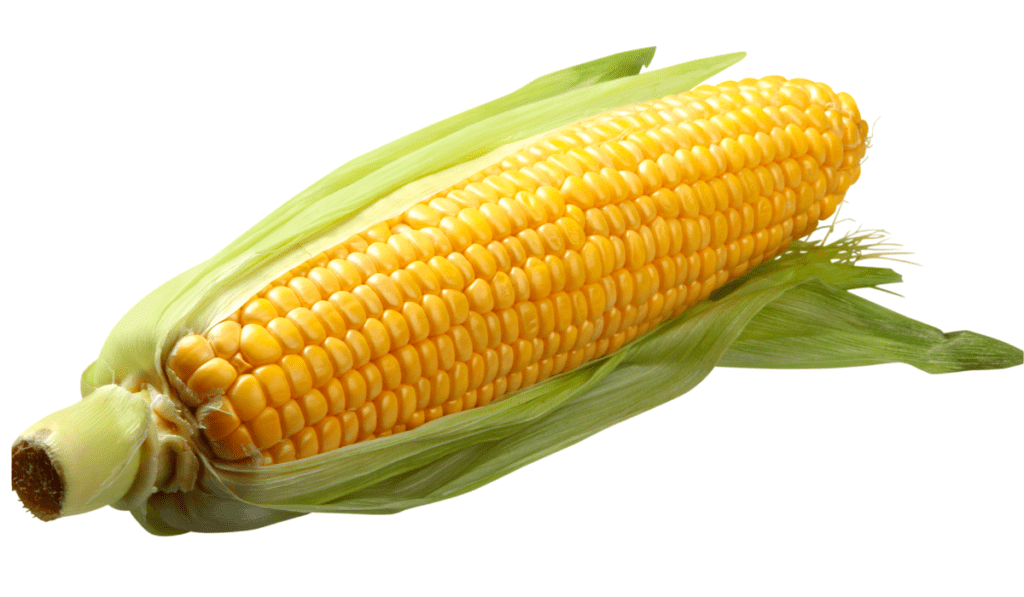Welcome to “The Ultimate Guide to Corn: Cultivation, Uses, and Global Trade.” This all-encompassing guide delves deep into the world of corn – a crop that is not only a fundamental food source but also a pivotal player in the global agricultural landscape and economy.
In an era where sustainable agriculture and food security are at the forefront of global discussions, gaining a comprehensive understanding of corn is invaluable. This guide is designed to be an essential resource for a diverse range of readers – from farmers and agronomists to culinary enthusiasts and industry experts – anyone keen on exploring the extensive world of this versatile crop.
What You’ll Discover:
➡ Chapter 1: Cultivation of Corn
➡ Chapter 2: Pest and Disease Management
➡ Chapter 3: Corn in Food and Cuisine
➡ Chapter 4: Industrial and Non-Food Uses of Corn
➡ Chapter 5: Global Trade and Economics of Corn
➡ Chapter 6: Geographical Considerations
➡ Chapter 7: The Future of Corn
Chapter 1: Cultivation of Corn
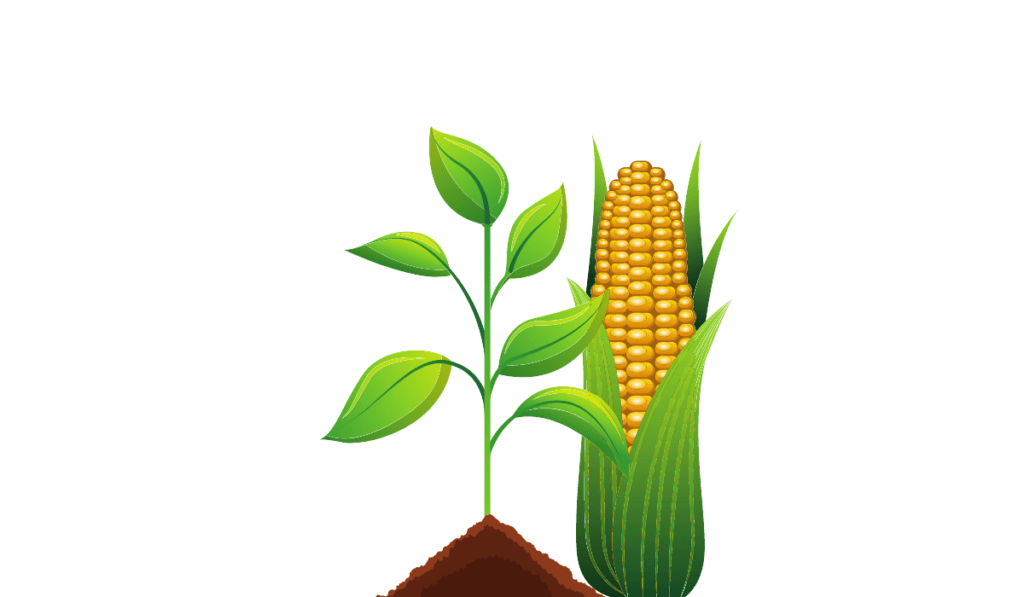
Corn, or maize, is not only a staple food for millions but also a backbone of agriculture in many economies. In this chapter, we’ll explore the comprehensive process of corn cultivation, offering a detailed guide suitable for both seasoned farmers and beginners. From the initial preparation of the soil to the final harvesting techniques, this chapter covers every critical step in growing this vital crop.
Planting Corn
- Best Soil Types and Climate Conditions:
- Soil Requirements: Corn grows best in well-drained, fertile loams with a neutral pH. Soil testing is recommended to determine the need for any soil amendments.
- Climate Needs: Corn requires a warm climate with temperatures between 60°F and 95°F. It is a sunlight-loving plant, needing plenty of sunshine for optimal growth.
- Seasonal Considerations and Sowing Techniques:
- Planting Time: The ideal time to plant corn depends on the local climate, generally after the last frost when soil temperatures reach about 50°F.
- Sowing Methods: Plant corn seeds about 1 to 2 inches deep, spaced 9 to 12 inches apart. Rows should be spaced 30 to 36 inches apart to allow adequate space for growth.
Growing and Caring for Corn
- Watering, Fertilizing, and Managing Growth:
- Watering Needs: Corn requires consistent moisture, especially during the germination and pollination stages. Drip irrigation or timely watering is crucial.
- Fertilization: A balanced fertilizer, high in nitrogen, should be applied after the plants have established. Soil tests can guide specific nutrient requirements.
- Weed Management: Regular weeding is important, especially in the early stages of growth. Mulching can help control weeds and maintain soil moisture.
- Common Challenges in Corn Cultivation:
- Pests and Diseases: Corn is susceptible to pests like corn earworms and diseases such as rust and smut. Monitoring and timely intervention are key.
- Climatic Challenges: Extreme weather conditions, like drought or excessive rainfall, can impact corn growth. Implementing adaptive farming practices is essential.
Harvesting Corn
- Signs of Maturity and Harvesting Techniques:
- Indicators of Maturity: Corn is ready for harvest when the kernels are plump and the milk line (the stage of kernel development) is evident. The husks should be brown, and the cobs should feel firm.
- Harvesting Methods: Corn can be harvested by hand or using machinery, depending on the scale of cultivation. It’s important to harvest at the right time for the best quality.
- Post-Harvest Handling and Storage:
- Drying and Storage: Proper drying is essential to prevent mold and spoilage. Store corn in a cool, dry place, and for seed preservation, ensure it is kept at low moisture levels.
- Processing: For industrial or commercial use, corn may undergo further processing, such as milling or grinding.
Successful corn cultivation requires an understanding of the plant’s needs and careful management of resources. By paying close attention to soil conditions, climate, pest and disease control, and timely harvesting, farmers can ensure a bountiful and high-quality corn crop.
Chapter 2: Pest and Disease Management in Corn Cultivation

Effective management of pests and diseases is crucial in corn cultivation, directly impacting yield quality and quantity. This chapter offers an in-depth exploration of the various challenges corn crops face from pests and diseases and provides comprehensive strategies for their management.
Common Pests and Diseases in Corn
- Identification and Prevention:
- Corn Borer and Corn Earworm: Two of the most damaging pests, they can be identified by their feeding patterns on the corn ears and stalks. Preventive measures include crop rotation and planting resistant varieties.
- Rootworms: These pests attack the roots of corn plants. Rotating non-corn crops can significantly reduce rootworm populations.
- Fungal Diseases: Diseases like gray leaf spot, northern corn leaf blight, and rusts are common. These can be identified by lesions and discoloration on leaves and stems.
- Organic and Chemical Control Methods:
- Organic Controls: Include natural predators, biopesticides, and cultural practices like crop rotation and maintaining crop residue.
- Chemical Controls: Insecticides and fungicides can be effective but should be used judiciously to avoid resistance buildup and minimize environmental impact.
Integrated Pest Management (IPM) Strategies
- Sustainable Practices in Pest and Disease Control:
- Monitoring and Thresholds: Regular scouting for pest and disease symptoms is vital. Action should be taken only when pests or diseases reach a level that could cause economic harm (economic threshold).
- Combination of Practices: IPM involves integrating biological, cultural, mechanical, and chemical practices. This holistic approach reduces reliance on any single method and promotes sustainable pest and disease control.
- Innovative Approaches in Corn Pest Management:
- Biotechnology: Genetically modified corn that is resistant to certain pests and diseases is an evolving field.
- Precision Agriculture: Using technology like drones for monitoring and targeted pesticide application can enhance pest and disease management efficiency.
Challenges and Best Practices
- Resistance Management:
- Pesticide Resistance: Rotating different classes of pesticides and integrating non-chemical methods can help manage and prevent resistance.
- Host Plant Resistance: Developing and planting varieties resistant to specific pests and diseases is a proactive approach.
- Environmental Considerations:
- Impact on Non-target Organisms: Consider the effects of pest control methods on beneficial insects and the surrounding ecosystem.
- Regulatory Compliance: Adherence to local and national regulations regarding pesticide use is critical.
Effective pest and disease management in corn cultivation is a dynamic and critical component of successful farming. By understanding the pests and diseases that affect corn, and implementing a combination of management strategies, farmers can protect their crops, maximize yields, and contribute to sustainable agricultural practices.
Chapter 3: Corn in Food and Cuisine
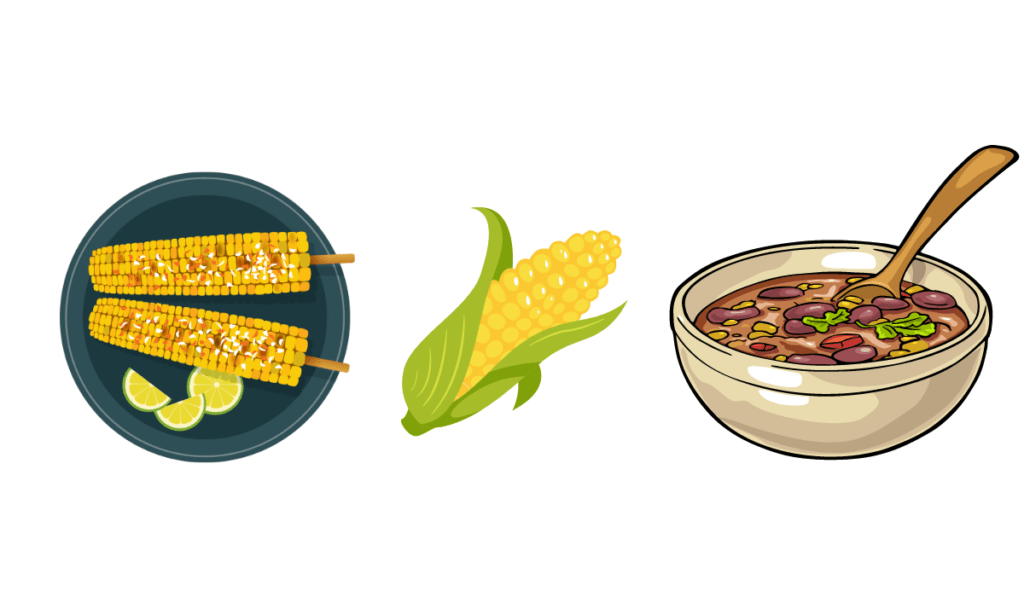
Corn’s versatility in the culinary world is as vast as its global significance. In this chapter, we delve into the nutritional profile of corn, its health benefits, and its diverse uses in various cuisines. Whether you are a professional chef, a home cook, or a nutrition enthusiast, this chapter offers a comprehensive look at corn’s role in food and cuisine.
Nutritional Value of Corn
- Detailed Breakdown of Nutrients in Corn:
- Macronutrients: Corn is primarily composed of carbohydrates, with a moderate amount of protein and a low fat content. It’s also a good source of dietary fiber.
- Vitamins and Minerals: It contains essential vitamins such as B-vitamins (particularly niacin and B6) and is a source of important minerals like magnesium, phosphorus, and potassium.
- Health Benefits and Dietary Considerations:
- Digestive Health: The fiber content in corn aids in digestion and helps in maintaining a healthy gut.
- Energy Source: As a high-carbohydrate food, corn is an excellent energy source, making it a staple in many diets.
- Antioxidants: Certain varieties of corn, like blue corn, are high in antioxidants which play a role in preventing chronic diseases.
Culinary Uses of Corn
- Preparing and Cooking Corn:
- Basic Preparation: Corn can be boiled, grilled, roasted, or steamed. The methods of preparation vary widely across different cultures and cuisines.
- Processing Forms: Corn is processed into various forms such as cornmeal, corn flour, popcorn, and sweet corn, each having unique culinary uses.
- Recipes for Corn-Based Dishes and Products:
- Traditional Dishes: Dishes like Mexican tortillas, Italian polenta, American cornbread, and African pap highlight the global culinary influence of corn.
- Innovative Culinary Creations: Modern cuisine sees corn in various forms – from gourmet dishes to vegan and gluten-free options, showcasing its versatility.
Dietary Trends and Corn
- Corn in Plant-Based Diets:
- Vegetarian and Vegan Cooking: Corn is a staple in plant-based diets, used in a variety of dishes, providing both nutrition and taste.
- Gluten-Free Options: For those with gluten intolerance, corn-based products offer a safe and tasty alternative.
- Sustainable Eating and Corn:
- Local and Seasonal Use: Corn’s widespread cultivation makes it a prime candidate for local and seasonal eating practices, contributing to sustainable food systems.
Corn’s culinary versatility, combined with its nutritional benefits, makes it a cherished ingredient in kitchens worldwide. This chapter not only celebrates the traditional and contemporary culinary uses of corn but also encourages readers to explore and innovate with this incredible grain.
Chapter 4: Industrial and Non-Food Uses of Corn
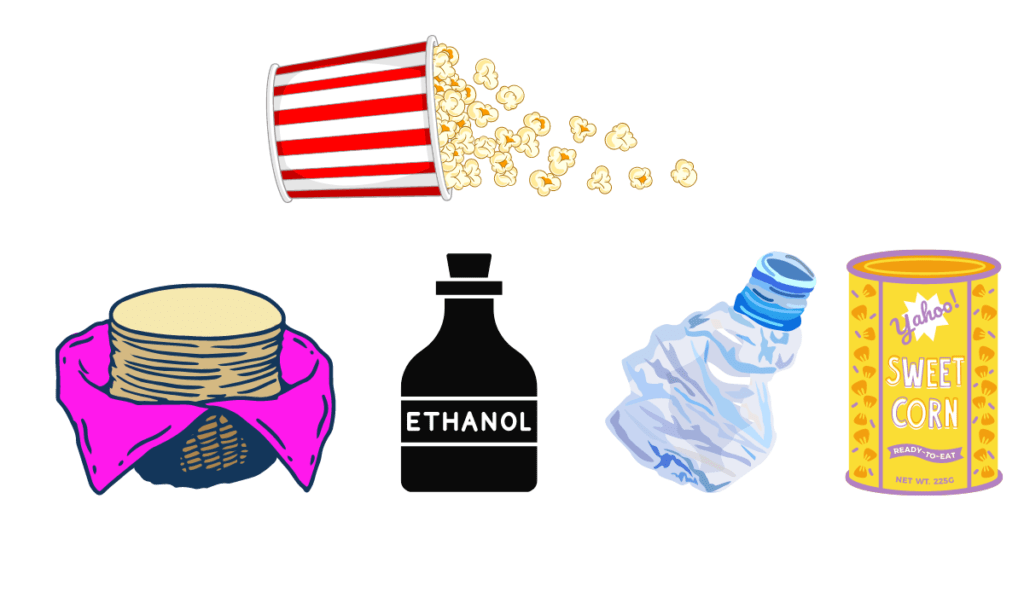
While corn is widely recognized for its culinary uses, its role extends significantly into the industrial realm. This chapter explores the myriad of ways corn is utilized in non-food contexts, highlighting its versatility and importance in various industries.
Corn in Industry
- Corn in Manufacturing (Ethanol, Plastics, etc.):
- Biofuel Production: Corn is a primary feedstock for ethanol, a renewable fuel source. The process involves fermenting the starch in corn kernels to produce ethanol.
- Bioplastics and Packaging: Corn-based polymers are used to produce biodegradable plastics, offering a sustainable alternative to traditional petroleum-based plastics.
- Corn Starch in Manufacturing: Corn starch finds applications in pharmaceuticals, paper products, and textiles, serving as a binder, thickener, and adhesive.
- Environmental Implications:
- Sustainability: Corn-based products, particularly in packaging and plastics, reduce dependency on non-renewable resources and decrease the carbon footprint.
- Agricultural Impact: The growing demand for industrial corn can influence agricultural practices, underlining the need for sustainable farming to meet industrial needs without compromising environmental health.
Innovative Non-Food Applications
- Recent Advancements and Future Potential:
- Biochemicals: Corn is increasingly being used to produce biochemicals, which serve as ingredients or intermediates in various chemical processes.
- Biomedical Applications: Innovations include using corn-based materials in biomedical devices and drug delivery systems, leveraging their biocompatibility and biodegradability.
- Corn in Cosmetics and Personal Care:
- Use of Corn Derivatives: Products like corn starch are used in cosmetics and personal care items for their absorbent and soothing properties.
- Natural and Sustainable Beauty Products: The trend towards natural ingredients in the beauty industry is further boosting the use of corn derivatives.
Challenges and Considerations
- Economic and Environmental Balance:
- Resource Allocation: Balancing corn use for food versus industrial purposes is crucial, especially in regions where food security is a concern.
- Environmental Costs: While corn-based products are often more sustainable, their production still requires consideration of land use, water consumption, and overall environmental impact.
- Technological and Market Developments:
- Innovations in Processing: Technological advancements in processing corn for industrial uses are leading to more efficient and environmentally friendly methods.
- Market Dynamics: The demand for corn-based industrial products is influenced by factors such as global oil prices, environmental policies, and consumer trends.
The industrial and non-food applications of corn demonstrate the crop’s remarkable versatility. As industries continue to seek sustainable and renewable resources, corn’s role is likely to expand further, making it an integral part of the global economy and a key player in the push towards environmental sustainability.
Chapter 5: Global Trade and Economics of Corn

Corn’s significance extends far beyond fields and farms, playing a pivotal role in the global economy. This chapter delves into the intricate web of global trade surrounding corn, examining the roles of major exporters and importers, the influence of market dynamics, and the crop’s profound economic impact on farming communities worldwide.
Leading Exporters and Importers
- Analysis of Top Corn Producing Countries:
- United States: The largest producer and exporter of corn, with a significant portion of its crop used for both domestic consumption and international trade.
- Brazil and Argentina: These countries are key players in the global corn market, known for their large-scale, export-oriented corn production.
- European Union: While a major producer, the EU also imports substantial amounts of corn, primarily for livestock feed.
- Major Importers and Their Dependencies:
- China and Japan: Among the largest importers of corn, these countries rely heavily on imports for animal feed and industrial uses.
- Mexico: A significant importer of corn, especially from the United States, primarily for human consumption and animal feed.
Trade Dynamics and Market Trends
- Market Influences:
- Commodity Prices: Global corn prices are influenced by various factors, including weather conditions, yield forecasts, and energy prices (due to corn’s use in ethanol).
- Biofuel Policies: Government policies on biofuels significantly impact corn markets, as a substantial portion of corn production is used for ethanol.
- Evolving Trade Agreements and Policies:
- Trade Agreements: Bilateral and multilateral trade agreements can dramatically impact corn trade flows and pricing.
- Subsidies and Tariffs: Governmental policies, including subsidies for corn farmers and tariffs on imported corn, play a crucial role in shaping the global corn market.
The Business of Corn Farming
- Economic Impact on Farmers:
- Profitability: Factors affecting the profitability of corn farming include input costs (seeds, fertilizers, machinery), market prices, and yield.
- Small vs. Large Scale Farming: The economic realities differ greatly between smallholder farmers and large-scale commercial farms, impacting their market strategies and sustainability.
- Sustainable and Profitable Farming Practices:
- Technological Advancements: The adoption of precision agriculture and biotechnology can enhance yield and sustainability.
- Market Diversification: Diversifying into different corn markets (such as food, feed, and fuel) can provide farmers with a buffer against market volatility.
Geopolitical Factors and Global Policies
- Impact of Trade Agreements and Political Relations:
- Global Relations: Political relations between countries can lead to the establishment or dismantling of trade barriers, directly impacting corn trade.
- Emerging Markets: The rise of new markets can shift the global trade landscape, creating new opportunities and challenges for corn exporters and importers.
- Regulatory and Environmental Considerations:
- Environmental Policies: Global environmental policies and agreements can affect corn production practices, especially regarding genetically modified crops and sustainable farming.
- Food Security Concerns: Policies aimed at ensuring food security can influence corn trade, particularly in import-dependent countries.
The global trade and economics of corn are complex and dynamic, influenced by an array of factors from local farming practices to international policies. Understanding these intricacies is vital for stakeholders across the corn value chain, from producers to policymakers, as they navigate the challenges and opportunities in the global corn market.
Chapter 6: Geographical Considerations in Corn Cultivation
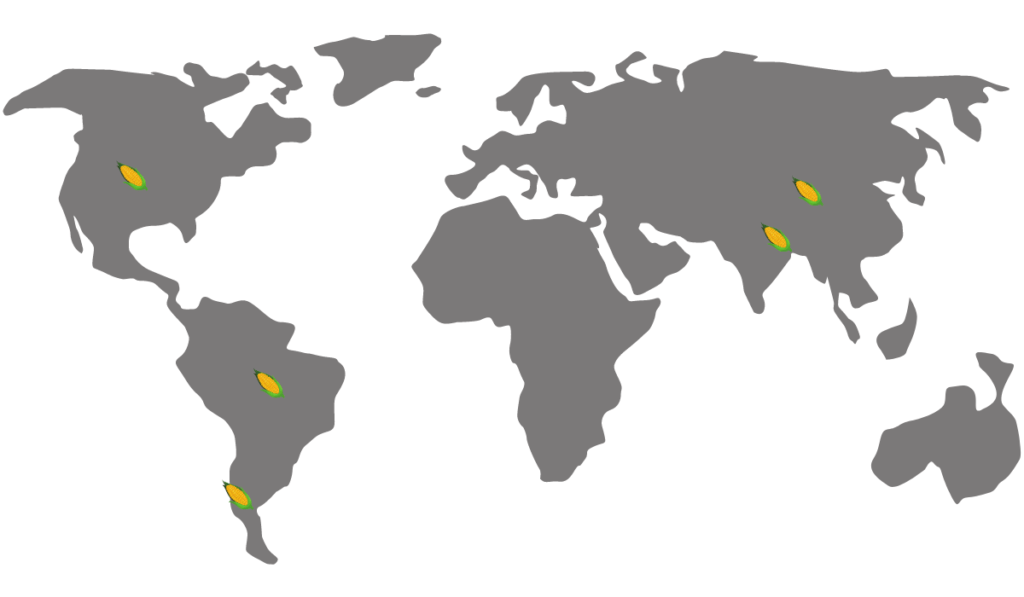
The cultivation of corn is significantly influenced by geographical factors. This chapter delves into how different regions around the world affect the growth of corn and how farmers adapt their cultivation practices to local environments for optimal production.
Optimal Regions for Corn Cultivation
- Global Growing Zones:
- Ideal Climatic Conditions: Corn requires a specific climate with warm temperatures and sufficient rainfall. It typically thrives in areas with a long, frost-free growing season.
- Major Producing Areas: The United States’ Corn Belt, parts of Brazil and Argentina in South America, and regions in China and India are among the world’s primary corn-growing areas, each with their unique climatic conditions.
- Analysis of Global Growing Zones:
- North America: The U.S. Corn Belt is characterized by its fertile soil and suitable climate, making it one of the most productive corn-growing regions globally.
- South America: Brazil and Argentina benefit from a favorable climate for corn, but they face challenges like soil degradation and the need for irrigation in certain areas.
- Asia: In China and India, corn cultivation varies significantly with regional climate variations, requiring different farming practices.
Adapting Cultivation Practices to Local Environments
- Soil Management and Fertility:
- Soil Types and Preparation: Different soil types, from loams to clay, require specific preparation and management techniques for successful corn cultivation.
- Fertilization and Soil Health: Tailoring fertilizer use to local soil conditions is crucial for maintaining soil health and ensuring high yields.
- Climate Adaptation Strategies:
- Irrigation in Drier Regions: In areas with less rainfall, efficient irrigation systems are vital for corn cultivation.
- Frost and Heat Tolerance: Selecting corn varieties that are tolerant to local temperature extremes, whether frost or high heat, can be critical.
- Pest and Disease Management:
- Local Pest and Disease Challenges: Each region has specific pest and disease challenges, requiring localized integrated pest management strategies.
- Resistant Varieties: Planting disease-resistant and pest-tolerant corn varieties can be crucial in managing local environmental challenges.
Sustainability and Environmental Considerations
- Sustainable Agricultural Practices:
- Reducing Environmental Impact: Implementing practices like reduced chemical use, conservation tillage, and responsible water management can help in making corn cultivation more sustainable.
- Carbon Footprint Considerations: Understanding the carbon footprint of corn production and implementing practices to reduce it are essential in the context of climate change.
- Balancing Production with Conservation:
- Land Use Management: The expansion of corn cultivation needs to be balanced with the preservation of natural habitats, forests, and biodiversity.
Geographical considerations are crucial in shaping the practices and success of corn cultivation. By understanding and adapting to local environmental conditions, farmers can optimize their corn production while ensuring sustainability. This adaptability, combined with a commitment to environmental stewardship, is key to the future of corn cultivation worldwide.
Chapter 7: The Future of Corn
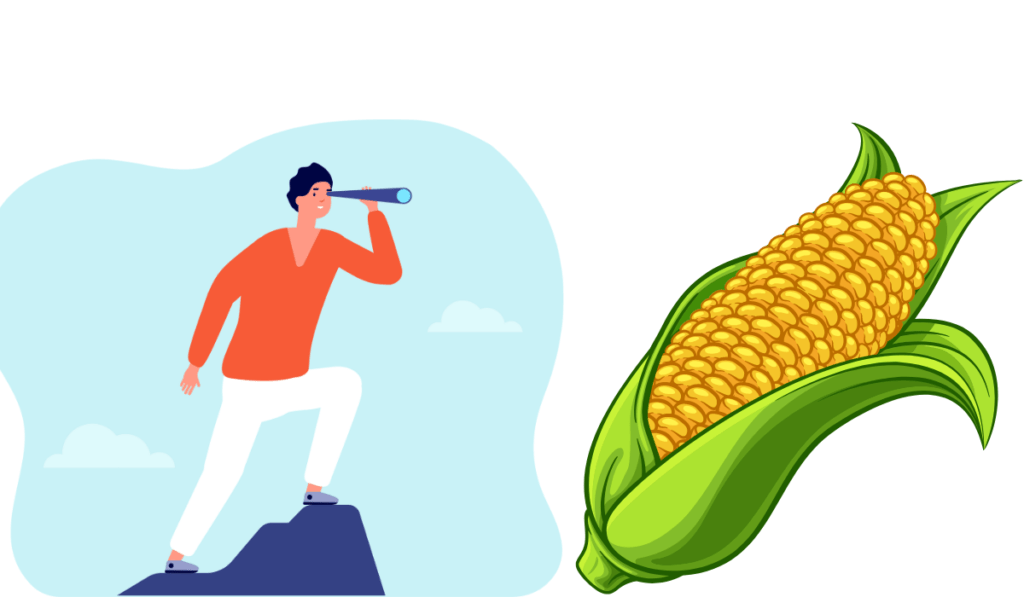
Corn, a crop deeply embedded in global agriculture, faces a future filled with opportunities and challenges. This chapter explores the advancements in cultivation techniques, the impact of biotechnology, and how changes in global demand and climate conditions are shaping the future of corn.
Advancements in Cultivation Techniques
- Biotechnology and Genetic Modification:
- GMO Corn: Genetically modified corn has been developed to enhance yield, pest resistance, and drought tolerance. These advances have revolutionized corn cultivation in many parts of the world.
- Gene Editing: Emerging technologies like CRISPR offer the potential for more precise genetic modifications, enabling the development of corn varieties with specific desired traits, such as enhanced nutritional value or adaptability to extreme environmental conditions.
- Climate Change Adaptation Strategies:
- Developing Resilient Varieties: In response to climate change, breeding corn varieties that can withstand extreme weather conditions, such as drought or excessive rainfall, is becoming increasingly important.
- Precision Agriculture: Advances in technology, including satellite imagery, drones, and IoT devices, enable more precise and efficient farming practices. These tools help farmers make data-driven decisions to optimize water use, soil health, and pest control.
Emerging Trends in Corn Use
- Shifts in Consumer Preferences:
- Increased Demand for Plant-Based Products: As consumer preferences shift towards plant-based diets, corn is likely to play a significant role as a source of protein and other nutrients.
- Corn in Health Foods: With a growing focus on health and wellness, corn’s role in producing gluten-free and high-fiber food products is expanding.
- Industry Demand:
- Biofuels: The use of corn for ethanol production is likely to continue, influenced by energy policies and the global push for renewable energy sources.
- Biodegradable Materials: The demand for sustainable and eco-friendly materials in various industries, including packaging and textiles, is paving the way for increased use of corn-based bioplastics.
Sustainability and Environmental Impact
- Sustainable Farming Practices:
- Balancing Yield and Environmental Health: Implementing sustainable practices such as reduced chemical use, conservation agriculture, and responsible water management is essential to ensure the long-term viability of corn farming.
- Carbon Footprint: Efforts to reduce the carbon footprint of corn production, including practices like no-till farming and cover cropping, are vital in the context of climate change.
- Technological Innovations and Policy Shifts:
- Adoption of Smart Farming Technologies: Leveraging smart farming technologies can lead to more sustainable and efficient corn production.
- Policy and Regulatory Changes: Government policies and regulations, particularly those related to biofuels, GMOs, and sustainable farming, will continue to influence the future of corn cultivation and use.
The future of corn is being shaped by technological advancements, changing market demands, and the urgent need for sustainable agricultural practices. As one of the world’s most important crops, corn will continue to play a crucial role in food security, industry, and the global economy. Adapting to the changing landscape, from biotechnological innovations to climate change adaptation strategies, will be key for stakeholders in the corn industry.
What are the best conditions for growing corn?
Corn grows best in well-drained, fertile soils with a neutral pH and requires a warm climate with full sunlight. Ideal temperatures for corn are between 60°F and 95°F. Planting should occur when soil temperatures reach about 50°F, typically after the last frost in spring.
How do corn’s industrial uses impact the environment?
Corn’s industrial uses, such as in the production of ethanol and bioplastics, have both positive and negative environmental impacts. While these applications provide renewable and biodegradable alternatives to fossil fuel-based products, they also require significant agricultural resources. Sustainable farming practices and efficient resource management are crucial to minimizing the environmental footprint of industrial corn use.
What advancements in corn cultivation are expected in the future?
Future advancements in corn cultivation include the development of genetically modified and gene-edited corn varieties with enhanced traits like drought resistance, nutrient efficiency, and improved yield. Precision agriculture, utilizing advanced technologies such as satellite imagery and AI, is also expected to play a significant role in making corn farming more efficient and sustainable.
Can corn be a sustainable choice in a plant-based diet?
Yes, corn can be a sustainable choice in a plant-based diet. It is a versatile and nutritious crop that can be grown in various climates and soil types. When cultivated using sustainable practices, corn can be a key component of a plant-based diet, providing essential nutrients and energy with a relatively low environmental impact compared to some other crops.
Conclusion
In “The Ultimate Guide to Corn: Cultivation, Uses, and Global Trade,” we have navigated the extensive realm of corn, a crop integral to global agriculture, economy, and culture. This journey has highlighted corn’s versatility, from its role in sustainable farming practices to its significance in the global market and its varied industrial applications.
As we look forward, the future of corn is shaped by advancements in agricultural technology, environmental sustainability, and shifting global demands. The role of stakeholders – farmers, scientists, policymakers, and consumers – is pivotal in adapting to these changes and ensuring the ongoing success and sustainability of corn cultivation and utilization.
This guide aims to deepen your appreciation for corn and inspire informed and responsible involvement in its cultivation, trade, and consumption. As corn continues to play a crucial role in feeding and supporting the world, understanding its multifaceted nature is more important than ever.

